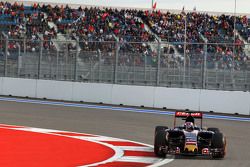Renault: USA GP preview
Rémi Taffin: "We will have our new specification of power unit available to use in Austin."

Photo by: Red Bull Content Pool















The Circuit of the Americas was designed by circuit guru Hermann Tilke and includes homages to some of the greatest corners of the championship. The flowing section in Sector 1 is a replica of Silverstone's Maggots and Becketts complex, while the tight section that opens Sector 3 resembles Hockenheim's stadium section. The radial turns of 16 – 17 are a mirror image of Istanbul’s iconic Turn 8, which was also Tilke-designed.
The track is very demanding on the tyres, so engine engineers will work with the chassis teams to reduce wheelspin in the corners and tyre wear. With 20 corners in total, it’s crucial to make the balance as smooth as possible to lengthen tyre life.
The track runs anti-clockwise. This will put the drivers’ necks under pressure in the opposite way to ‘normal’ but it is not expected to pose any particular problem for the power units.
Power Unit details
ICE - Austin is one of the most demanding tracks of the second part of the year for the ICE, with just under 50% of the lap taken at wide open throttle, rising to 55% in qualifying. The average speed will be around 200kph with top speed peaking at over 320kph.
The longest straight is the burst between Turns 11 and 12 at 1,016m. The power units will spend approx. 14secs at wide open throttle. Top speed is 325kph at the end of this straight in qualifying trim.
The changes in gradient stress the internals of the ICE. When going downhill the mechanical parts and lubricants are squashed to the bottom of the car but when going uphill they are pushed back upwards. These repeated changes of pressure are unusual on the calendar and will be monitored over the weekend to avoid any potential problems or pressure drops.
Turbocharger - Austin’s gradient changes are an important consideration. The run from pole to the first corner is the most acute example of the change in altitude. The track rises 25m over 500m – equivalent to a gradient of 1 in 20 but at its steepest is 1 in 8. This elevation change means the turbo rotates at a higher speed to generate the same amount of power at the top of the hill.
The low ambient humidity of the Texan grasslands has a big effect on the power units. The air will contain more oxygen and a naturally-aspirated ICE will generate more power, but the aridity is very taxing on the internals. A turbocharged engine mitigates this effect by varying the rotational speed to provide the correct amount of air to the ICE.
MGU-K - The circuit layout with its flowing corners in the first sector, straight line in the second sector and stop/start character of the last sector makes the consumption per kilometre one of the highest of the season. This makes energy recovery through braking crucial.
The third sector is very stop-start, but the hairpins and tight corners give the MGU-K a chance to recharge. At each corner, the driver will stamp on the brakes, putting large forces through the K and filling the battery once more.
Three hairpins triangulate the track; Turns 1, 11 and 12. Revs drop to 7,500rpm and the car speed to just 80kph. All three come after a long period of open throttle, meaning engine braking and rear stability on the apex are crucial. The exits and correct engine response from the hairpins are however equally important since they each lead back onto another straight.
MGU-H - A high percentage of Sector two is given to the long straight, which will give the MGU-H a chance to recover energy from the ICE.
The flowing section between Turns 2 and 4 require the driver to maintain a constant level of throttle. This will require the ICE to turn at a constant speed, producing a steady stream of exhaust gas, which the MGU-H can recover.
Rémi Taffin, Director of Operations
There’s very little not to love about Austin. The setting is impressive, the welcome is warm and the track is one of the best we visit all year. There are some very impressive corners and flowing complexes that challenge drivers, engineers and the technology we use. The power unit works in the mid to high range throughout the lap, with high average speeds and some very technical sections.
We will have our new specification of power unit available to use in Austin. The principal changes involve the internals of the ICE to give improved power and efficiency. We know that introducing the new PU will incur a grid penalty so the decision to use will be made in full consultation with the teams. At this point of the season obviously points are crucial so if circumstances allow then we will use on track.
Whatever spec we do use, we are looking forward to Austin. Our reliability has been good in the last three races and performance more in line with our expectations; both our teams just need a clean weekend to show the improved potential of both packages.
Renault Sport
Be part of Motorsport community
Join the conversationShare Or Save This Story
Subscribe and access Motorsport.com with your ad-blocker.
From Formula 1 to MotoGP we report straight from the paddock because we love our sport, just like you. In order to keep delivering our expert journalism, our website uses advertising. Still, we want to give you the opportunity to enjoy an ad-free and tracker-free website and to continue using your adblocker.



















Top Comments